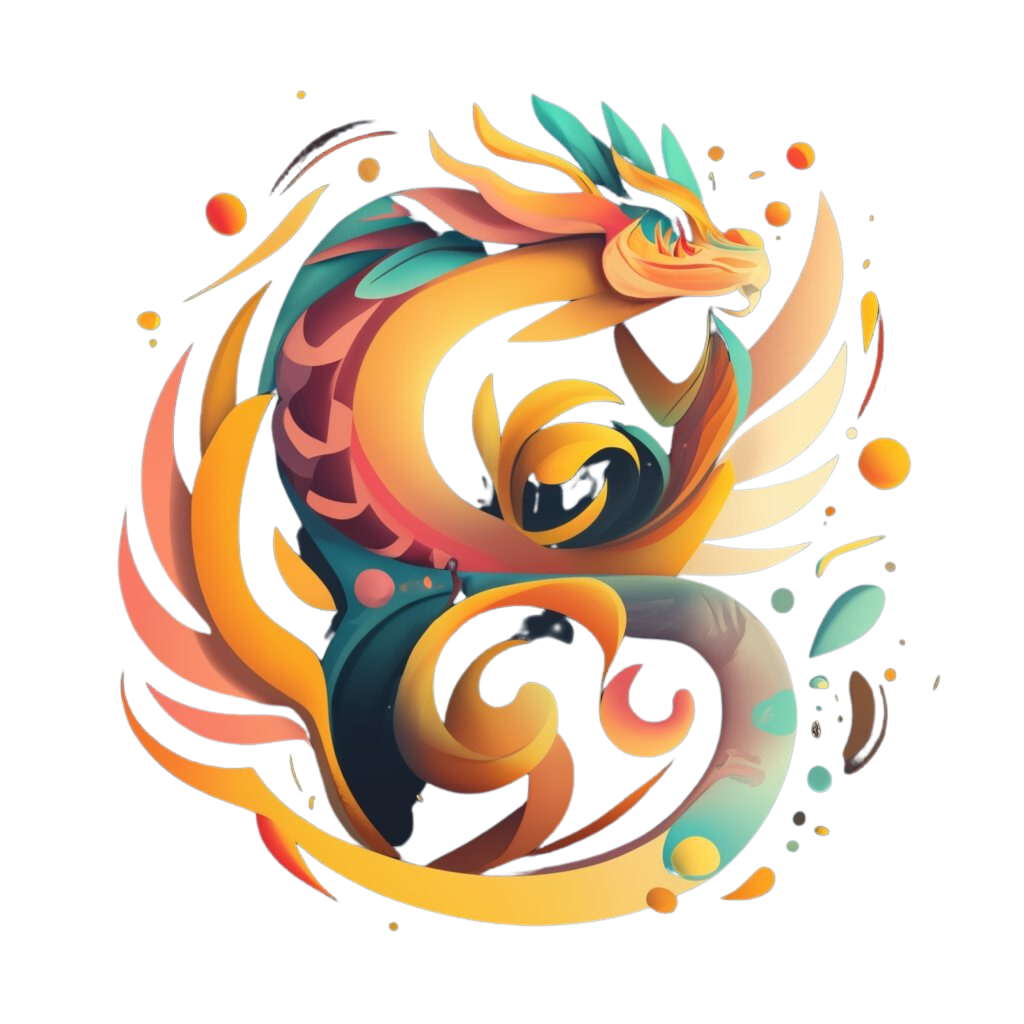West Asian Mythical Creatures have been part of stories for thousands of years. They include the Simurgh and Jinn, showing the deep stories of Middle Eastern folklore. Their adventures take us through Persian empires, Arabian trade routes, and Mesopotamian temples.
Beings like the Ghoul and Manticore are both feared and respected. These stories link old traditions to today's pop culture. They show us the values, fears, and dreams of ancient times.
The Rich Tapestry of West Asian Mythology
West Asian myths go back thousands of years. They come from ancient civilizations and are very colorful. These stories were told in river valleys and deserts.
They helped people feel connected across different empires and faiths. The Epic of Gilgamesh shows how myths shaped ideas of heroes and gods.
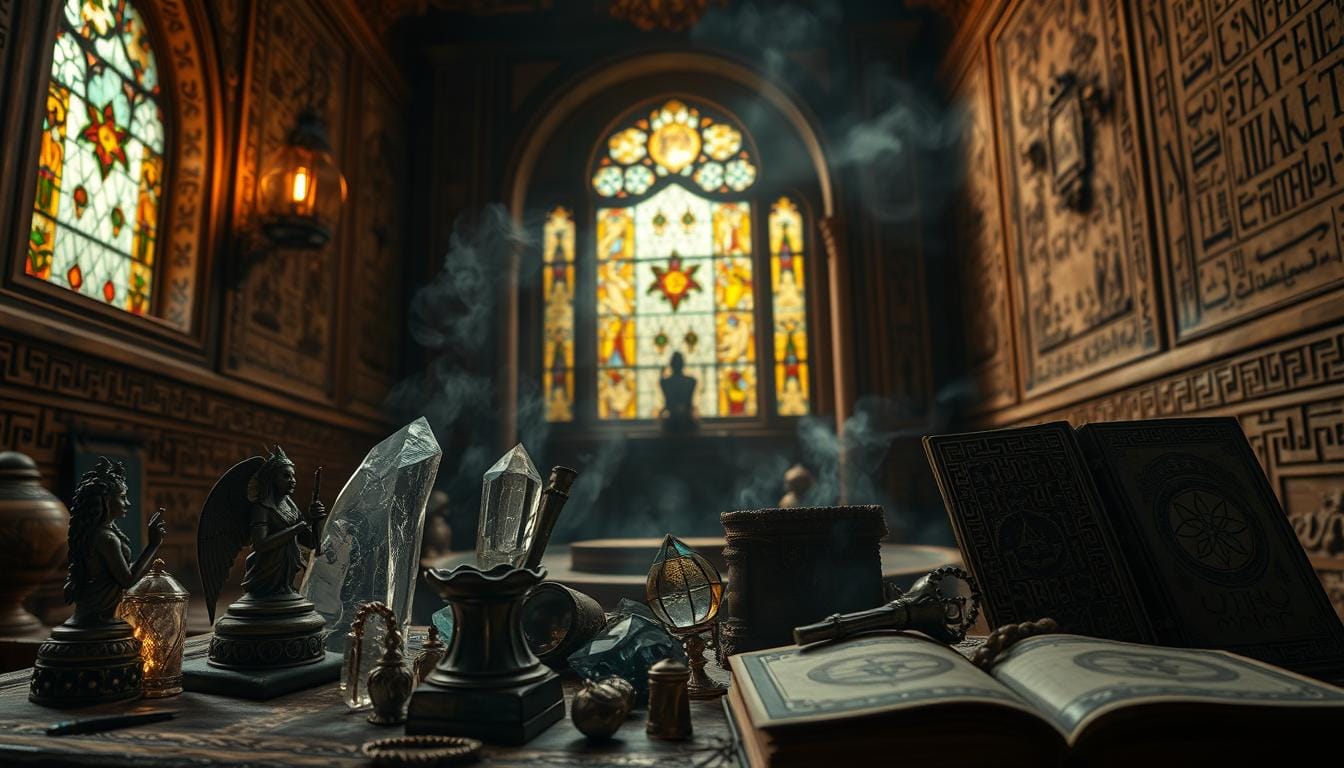
Ancient Origins of Mythological Traditions
Long ago, myths from ancient Mesopotamia started West Asian stories. Sumerian clay tablets told of Enki, the god of wisdom. Babylonian texts told of Marduk's fight against chaos.
Persian myths added more, with the Shahnameh telling of kings and magical beings. These stories explained the world and mixed with everyday life.
Geographic Diversity of Mythical Tales
Myths varied across the Tigris-Euphrates valleys and Iranian plateaus. In the Arabian Peninsula, djinn lived in oases. Kurdish tales talked about mountain spirits.
Persian myths celebrated the Simurgh, a bird like a peacock. It stood for new beginnings. Each culture put its own twist on these stories, using local legends and places.
Religious Influences on West Asian Folklore
Zoroastrianism brought new ideas, like light vs. darkness. Later, Islam came and mixed old stories with new teachings. This made jinn into spirits in both old tales and the Quran.
Today, these old beliefs still show in festivals and rituals. They show how faith changed ancient stories into lasting symbols.
Fascinating West Asian Mythical Creatures and Their Powers
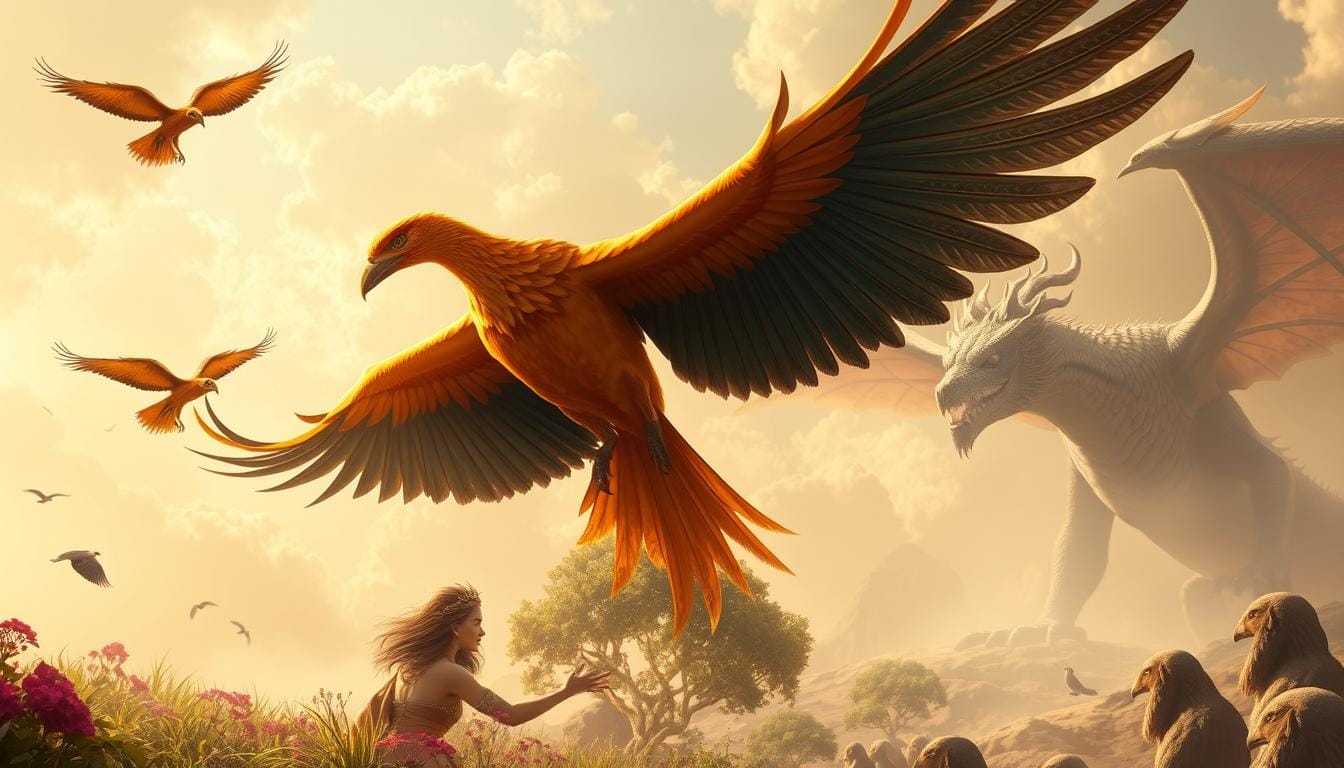
Step into the world of West Asian legends. Here, mythical beings with supernatural powers shape ancient tales. These creatures blend fear and wonder in equal measure.
The Majestic Simurgh: Guardian of All Birds
In Persian mythology, the Simurgh is a symbol of wisdom and power. It has a dog’s head, lion’s claws, and peacock feathers. Legends say it guards birds and helps heroes, like Fereydun in the Shahnameh.
Its powers include healing and granting immortality.
Jinn: Supernatural Beings of Smoke and Fire
Jinn folklore talks about these smokeless fire entities. They live in deserts and cities. They can be kind or play tricks.
Types like the Ifrit and Marid show their different sides. Islamic traditions also talk about them, mixing old beliefs with religious stories.
The Fearsome Ghoul of Desert Tales
Arabian ghoul stories tell of desert predators in burial grounds. Ghouls eat human remains and trick travelers. Over time, they became modern horror icons, showing the dangers of the unknown.
Persian Manticore Legends: The Human-Faced Beast
The manticore has a lion’s body, human face, and scorpion tail. Its roar scares prey, and its sting is poisonous. Greek travelers like Ctesias brought tales of this beast to the West, mixing East and West imaginations.
Cultural Significance and Symbolic Meanings Behind the Legends
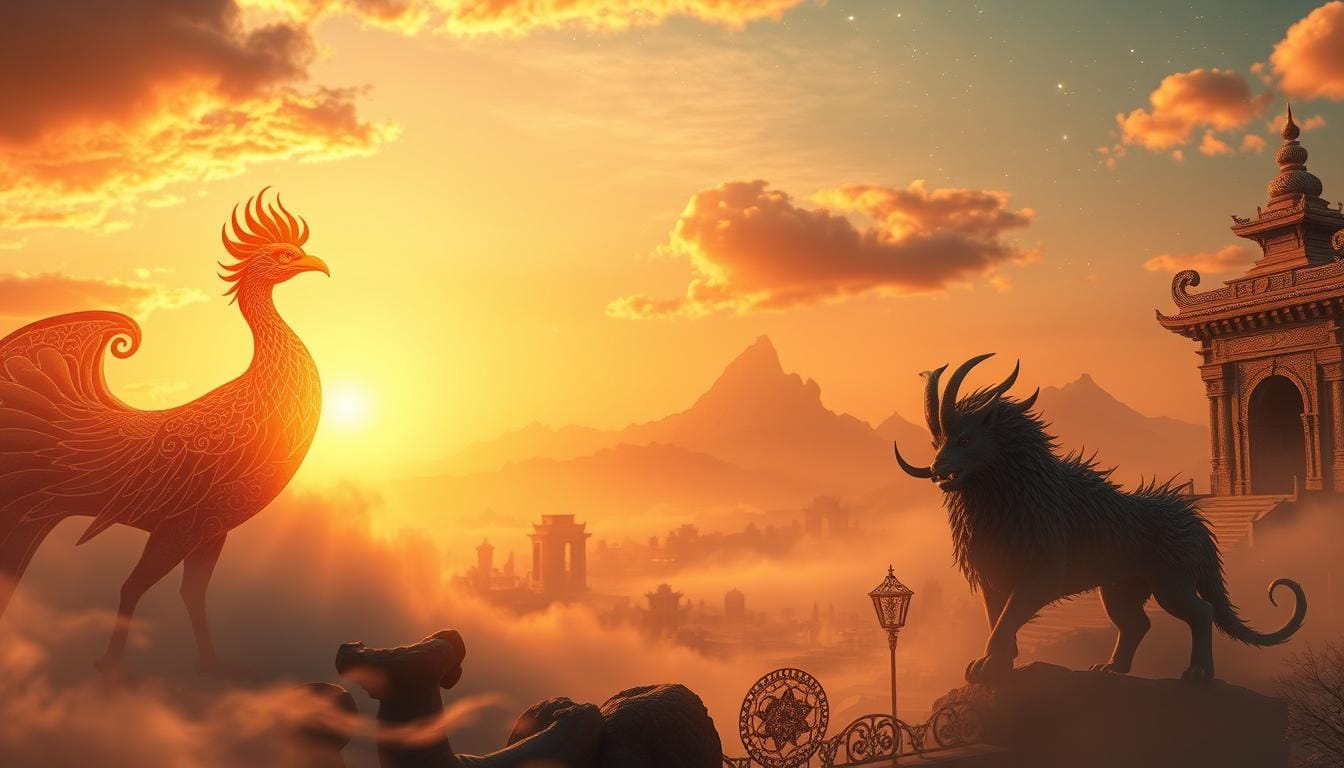
West Asian folklore shows how mythical creatures shaped old societies. Myths like the Simurgh or Jinn were more than stories. They showed cultural values and big questions.
Mythical creatures often linked to nature's secrets. The Simurgh had feathers that showed the sky and earth. It stood for balance between humans and gods. Jinn, born from fire, warned of forces beyond our sight.
Myths guided how people should act. The Ghoul's stories warned of desert dangers. They mixed survival tips with lessons against greed. Manticore tales taught about the dangers of being too proud.
Old legends also talked about big ideas we still think about today. They showed battles between good and evil. They told of humans searching for wisdom. These stories connect old beliefs to our curiosity about the world.
How West Asian Mythical Creatures Evolved Through Centuries
Mythologies in the Middle East changed a lot as empires came and went. The evolution of Middle Eastern mythology shows how stories changed with new beliefs and trade routes. From Zoroastrian dragons in Persia to Bedouin tales of the desert, ancient-to-medieval mythical creatures had meanings for their times.
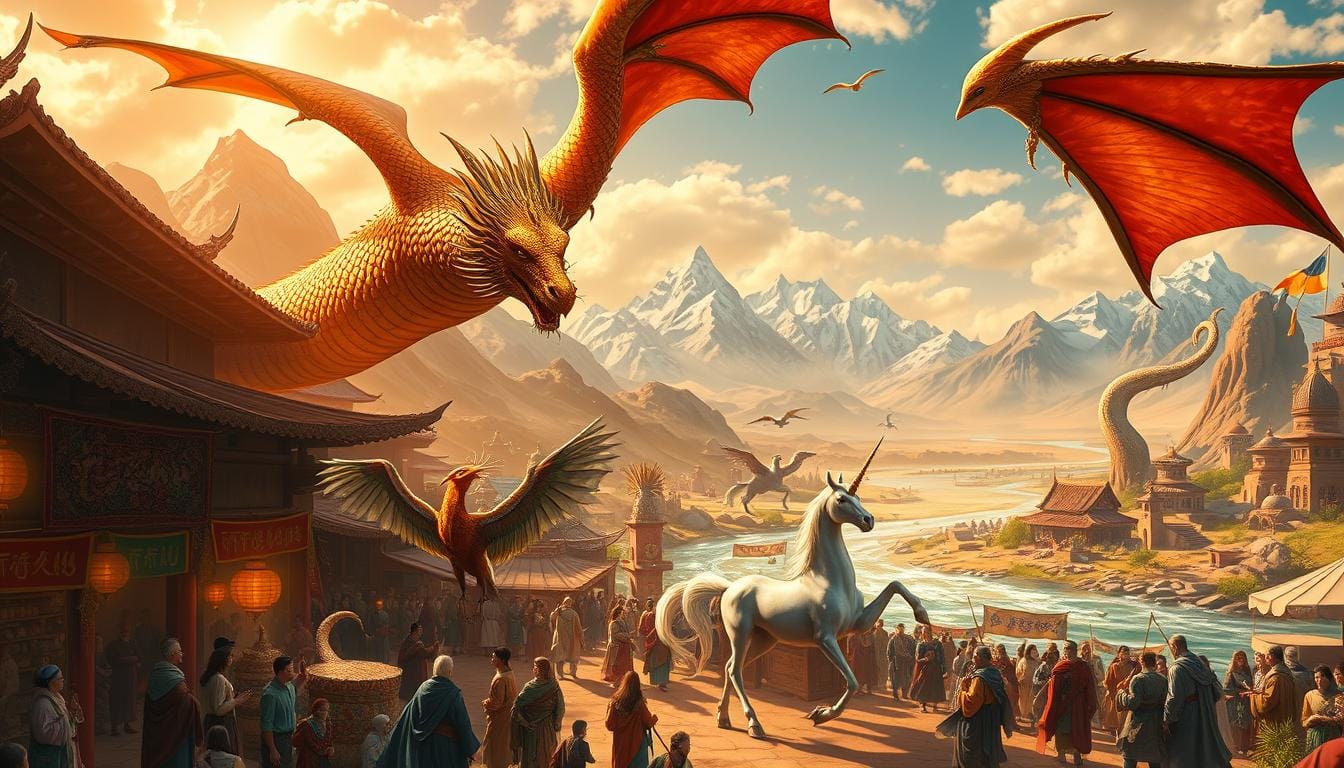
Before Islam, there were creatures like the Simurgh and azhdaha in old traditions. These beings often stood for natural forces or moral lessons. When Islam came, scholars mixed old myths with new teachings.
The Quran talked about jinn, changing them into spiritual beings. Poets kept old stories alive in One Thousand and One Nights. This shows how Islamic influence on folklore blended tradition with faith.
- Silk Road cultural exchange spread these tales far: Chinese poets wrote about the simurgh, and European knights reimagined manticore legends.
- Indian traders shared serpent myths with West Asian azhdaha stories, creating new creatures.
Each time period left its mark—from Persian fire spirits to Islamic-era jinn. This shows myths are living stories shaped by history’s flow.
West Asian Mythical Beings in Modern Entertainment and Art
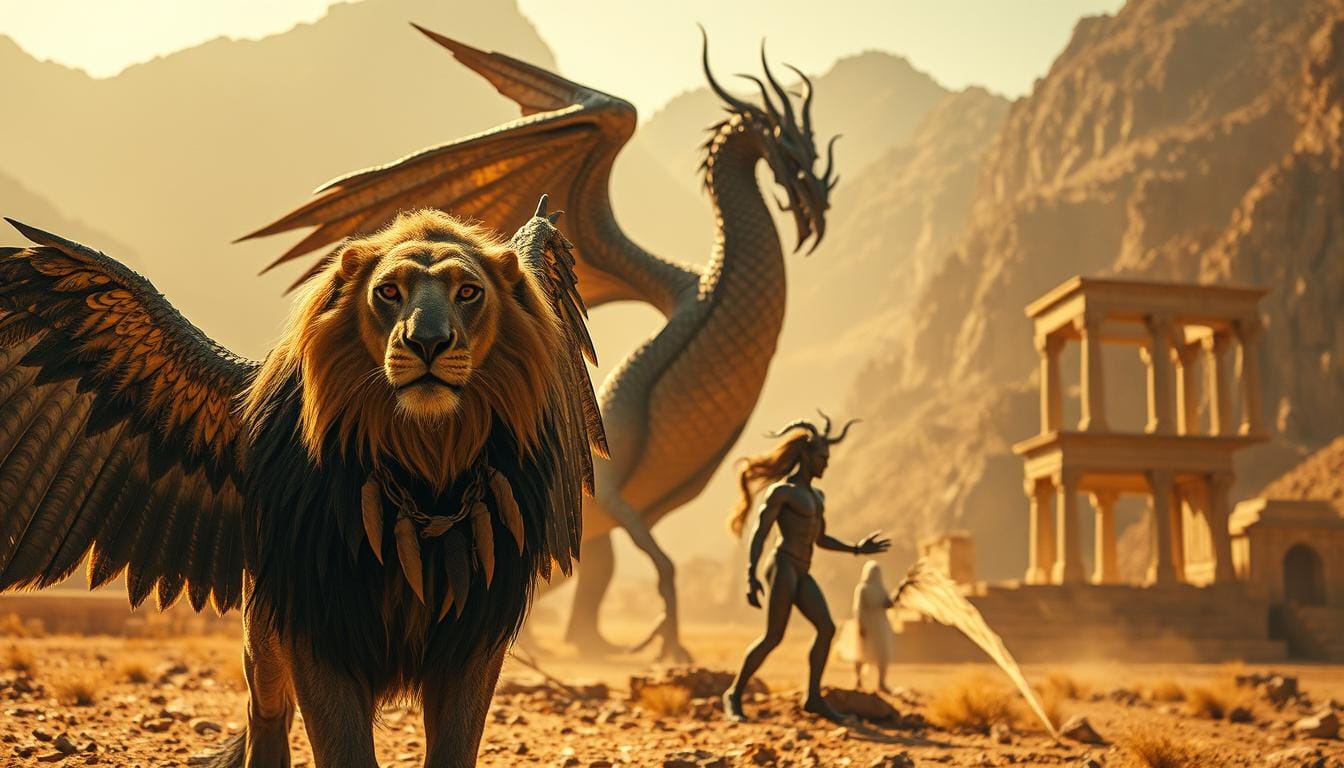
Mythical creatures in movies and media bring old stories to life. Films like Prince of Persia and Clash of the Titans show creatures from Persian myths. They mix action with cultural stories, making people curious about Middle Eastern tales.
Artists and game makers also find inspiration in these old stories. The Elder Scrolls games have Daedric Princes like jinn. Animated movies like Aladdin show ghuls and jinn in a new way. Even kids' books and comics, like Persepolis of Legends, introduce Persian myths in fun ways.
- Modern art mixes old miniatures with new designs, showing creatures like the manticore in a new light.
- TV shows like Lucifer hint at jinn stories, mixing them with today's tales.
- Games like Call of Cthulhu: Dark Arabian Nights let players meet mythical beings.
These stories don't just entertain; they keep old legends alive. By adding these tales to movies, games, and art, creators share them with everyone. They show that stories of jinn, simurgh, and ghouls are still important today.
Why These Ancient Legends Continue to Captivate Our Imagination
Mythology shows our shared human experiences. Stories of the Simurgh, Jinn, and other West Asian creatures explain life's mysteries. They face our primal fears.
These tales are not just old stories. They are timeless reflections of universal themes like courage and morality. They also explore the unknown.
For communities in the U.S. and beyond, these myths preserve cultural heritage. They connect diaspora generations to their roots. They offer identity and continuity.
Even in modern films or books, these stories adapt yet stay true. The manticore's ferocity or the ghoul's cunning remind us of their origins.
These legends endure by connecting past and present. They let us explore humanity's shared struggles and aspirations. Whether through a jinn's trickery or the Simurgh's wisdom, they show our common humanity.
As global cultures intertwine, these stories become bridges. They reveal what makes us unique and what unites us all. Next time you meet a mythical creature, remember: it's more than a story. It's a living thread in the fabric of who we are.
FAQ
What are West Asian mythical creatures?
West Asian mythical creatures are from old stories in places like Persia and Turkey. They include the Simurgh and Jinn. These beings show special traits and share values in many cultures.
How do West Asian myths differ from those in other cultures?
West Asian myths are filled with history and religion, like Zoroastrianism and Islam. They mix moral lessons, magic, and the bond between humans and nature. This is different from some other mythologies.
Can you provide examples of some popular West Asian mythical beings?
Yes! Famous ones are the Simurgh, a wise bird from Persian tales. There's also the Jinn, supernatural beings from Arabic stories. The Ghoul, a flesh-eater, and the Manticore, with a human face and a lion's body, are also well-known.
How have these mythical creatures evolved over time?
Over time, these creatures have changed a lot. They started in old traditions, then changed during the Islamic Golden Age. They evolved more through trade and cultural exchange, like on the Silk Road. These changes show how society, politics, and religion have shifted.
In what ways are these myths represented in modern entertainment?
West Asian mythical creatures appear in movies, TV, books, and games today. These stories take some liberties but still share the old legends. They show how these tales are still important today.
Why are these ancient legends still captivating to modern audiences?
These legends are still loved today because they talk about things we all think about. They cover fear, right and wrong, and the unknown. They connect old stories with today's tales, showing we're all connected.
